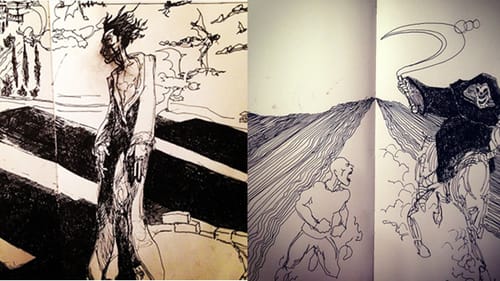Stay in the Loop
BSR publishes on a weekly schedule, with an email newsletter every Wednesday and Thursday morning. There’s no paywall, and subscribing is always free.
Wandering through the #Instamuseum
An artist considers Instagram

Following Susan and Lisa as we bike to the gnomes’ house, I think of the little house from my childhood on Red Lion Road in Northeast Philadelphia. Perched lower than the sidewalk, the house appeared so small that I thought gnomes lived in it with a red lion.
Today we are biking to another gnome house in Ithaca. Susan wants a picture of it for Instagram, where she posts pictures of street art and kitsch. Susan uses her life a travel writer, living in three cities on three continents, as a vantage point.
I have been ignorant about Instagram, knowing only that it’s a social media channel that allows individuals to post smartphone pictures, making them immediately available to the world. Like any social medium, it seeps into one’s life, as 300 million active monthly users can attest. But how does one navigate a network offering 70 million new images a day?
Identity is the street cop of control. Some Instagrammers post using their actual names; other are more mysteriously identified with a pseudonym, like @peachcooler, with whom I have regular contact now that I am an Instagram user. However, I not only don’t know @peachcooler, I don’t know if I don’t really know @peachcooler; although I don’t recognize anything he has posted.
The categorical hashtag
Unlike Facebook, where viewers must visit my account to see what’s posted, Instagram’s beat cop of identity allows photos to be tracked and viewed through hashtags. Susan will eventually label her picture #gnomes and #garden, making it accessible to anyone searching for those subjects. This opens the visual field extensively and categorically.
Human behavior has always been self-organizing, from the simple distinction between dead and alive to Aristotle’s more complex system of classification. Wandering through the endless photos of Instagram, there seems to be a natural taxonomy of photos defining three kinds of Instagram-posting activity: as curator, artist, or archivist.
As curator, Susan generally selects and presents others’ art. Artists post their own work. Sometimes the roles of curator and artist are combined, and it is difficult to decipher whether the person posting did the art or is curating another’s art. Archivists are busy documenting the minutiae of their lives — baby’s first steps, a great meal, friends at the beach — similar to the snapshots historically displayed on the front of a refrigerator. Of course, there are zealous posters who fuse all roles posting everyone’s art, babies, and dinners. For myself, while I am happy to see a strange baby walking, I only follow artists and a few curators. Likewise, I only post my art.
A distant knowing
I don’t actually know @muratzeybek35, but I follow him (I think he’s a him, based on the icon picture). Call it a distant knowing. His photographs mirror this sense of distance; they’re somewhere far away — certainly not the United States. But it’s not the subject’s distance that I find intriguing in the photos. It is the wistfulness of the photos making me think of the words dream, shadowy, sfumato.
An overall bleached palette contrasted with selected areas of full hue fosters the experience of distance in these photographs. A boy in a red shirt pulls a cart in front of a green building. It is a strong composition developed from a series of verticals and diagonals. The single horizontal element is the bottom strip of the boy’s shirt placed centrally, making the composition even more intriguing by dismissing supposed rules of composition. The linear aspect of the composition is augmented by ovals repeating the central oval of the boy’s face.
Visual poetry

Another artist, @melodybrzezinski, works primarily on paper, using a range of mark-making mediums (charcoal, ink, pencil, pastel) and creating energy from this synergy. Like @muratzeybek35, @melodybrzezinski uses a restrained tonal palette with splashes of color. Yet even when chromatic color is primary, there is no mistaking that darkness is master.
These drawings undermine both time and space by creating motion without change and form without place. When these formal properties are removed, boundaries dissolve, enabling a juxtaposition of images suggestive of visual poetry.
The line’s power
It may be my love of crosshatched lines or commitment to the sketchbook that draws me to the postings of @rtiberino. It may be his strong drawing skill — a skill emphasized in the training of artists at the Pennsylvania Academy of Fine Arts, from which @rtiberino graduated two years after I did.

In any event, @rtiberino has a drawing ability that enables line to go where it will go. This abandonment to line’s power is not seen in many Instagram line drawings, which often seem too self-conscious. In those drawings, the artist forces line into what the artist thinks it should do, like the beginner biker trying to control the bike not knowing that riding demands relinquishment of power to the bike. This respect for the line is also obvious in the political dimension that @rtiberino brings to his sketchbook. The political dimension without pretension gives the drawings presence outside propaganda or contrived emotion.
I follow these and other accounts where the art seems to exist beyond the virtual world of Instagram.
Gnomes’ home
When Susan, Lisa and I arrive at the gnomes’ house, I see a lawn filled with the results of years of collecting. I imagine the homeowner’s long commitment to collecting these statues, and somehow, this commitment and dedication validate the kitsch.
I can’t help but wonder what kind of commitment is demanded of art on Instagram. Can an expectation be made that art is substantiated beyond what is presented on smartphones in an instance? Does art, particularly those of traditional mediums, have to exist in actuality and beyond hashtags for my validation?
For more of the author's thoughts about Instagram, click here.
Sign up for our newsletter
All of the week's new articles, all in one place. Sign up for the free weekly BSR newsletters, and don't miss a conversation.

 Treacy Ziegler
Treacy Ziegler